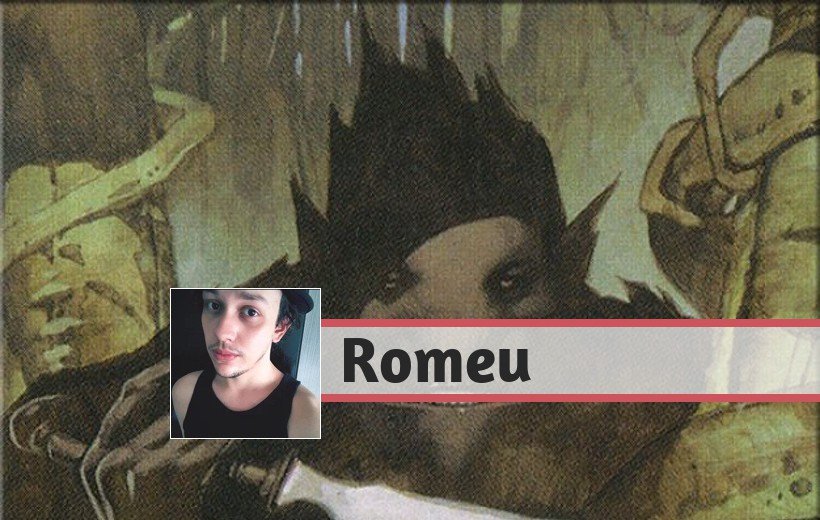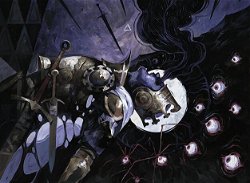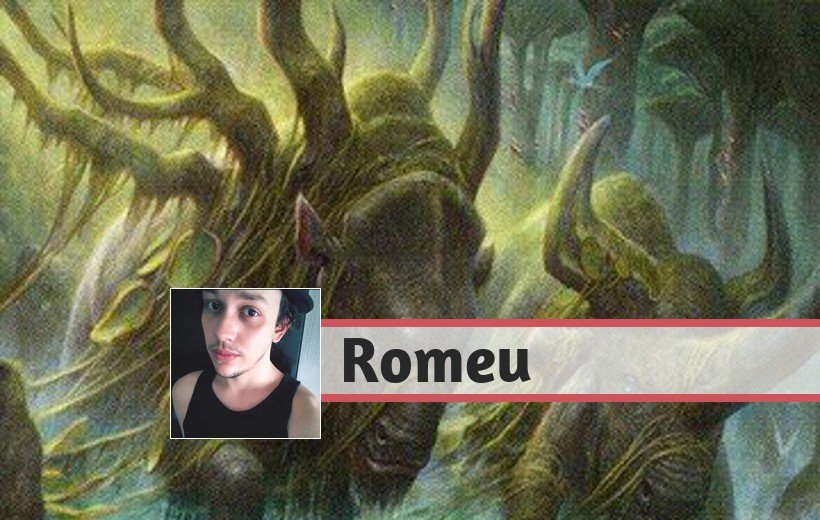Allow me to tell you a curious fact about Brazil's Pauper community:
There is no Pauper deck that is more popular in Brazil than Mono-Black Control.
If you say you want to start playing Pauper and ask players in a community for suggestions on which deck to build first, chances are at least one of them will mention that you can build Mono-Black.
And this has a history: Mono-Black Control was the best deck of the format for a few years, especially during the time when Brazilian tournaments used the “paper list”, where cards like Hymn to Tourach and Sinkhole were legal, which leveraged a deck that was already showing itself quite strong since the release of Gray Merchant of Asphodel in 2013.
This led Mono-Black Control to become a registered trademark of Pauper in the country, to the point that Gray Merchant of Asphodel was used for years as the “posterboy” of the Brazilian Pauper Nationals.
The years passed, the decks evolved, and yet it was always very common to see at least two or three Mono-Black decks being played in Pauper events, which even led players to trends like Rakdos Monarch, which was widely popularized in tournaments, specially in Rio de Janeiro.
Then the pandemic came, and tabletop games are still not possible in Brazil, and in that period, the format changed drastically even if we disregard the current badly polarized state of Pauper: Cascade decks now exist, Bonder's Ornament has become one of the main Card Advantage engines, Dimir Faeries has stabilized in the Metagame, among several other changes that we haven't yet seen on tabletop.
However, this does not mean that Mono-Black has been left out of the Brazilian imagination. On the contrary, as organizer of the Pauper Masters, I have several times seen Mono-Black or Black-Based decks like Rakdos Monarch win tournaments or be present in the Top 8, and this also occurs in other events, for example, the player Jesy, Recurring and faithful user of the classic Mono-Black Devotion, won the finals of Pauper Royale in April this year using the archetype.
In summary, Mono-Black Control is essentially a deck that at this point is part of the Brazilian tradition when we talk about Pauper. It is the best known deck, most recommended for those who want to get into the format, the most popular and will definitely continue, even when it is not among the Tier 1 decks of the format, loved and played by its most adept fans in the community.
The Brazilian Pauper community loves Mono-Black Control.
The Metagame
That said, Pauper currently remains in its miserable state which I mentioned just over a month ago in this article, but with one difference: Dimir Faeries has become increasingly present in this polarized format.
The format remains a three-deck format, with Dimir Faeries, Affinity and Storm always composing above 50% of the decks in the Top 32 of the Challenges, when they don't reach 60% or more of the Top 32 in a specific event, and given these circumstances and that we've been waiting for bans for months, it brings me and much of the community a sense of desolation and hopelessness about the current state of the format and a significant absence of any excitement or good prospect for the future of Pauper in the short term.
However, Pauper has one of the most dedicated and passionate communities in Magic, and this is due to the fact that the recognition that Pauper has received in recent years was only possible because the community came together for this purpose, and despite the numerous controversies or discussions that exist in the community as to what should be done, the direction the format needs to take, among other points, all agree on one point in particular: They want Pauper to have the recognition and opportunities to grow and become increasingly active in Magic's world.
And precisely because there is this passionate community and because of a significant portion of players who are grinders in the format, the Challenges continue to occur and go off without too many problems (although we are seeing a significant decrease in the number of players in these events), and there are still those brave enough to play with archetypes that don't fall on the Faeries-Storm-Affinity axis.
However, playing outside this axis doesn't mean ignoring them. Several players are looking to build their lists based on playing well against these decks, especially Storm for being the archetype with the biggest free-win button in the format today, or just ignore them and try to win the game before they win.
In terms of ignoring them, we have decks like Heroic, Burn and Elves, which can play the non-interactive game as well as Storm and take advantage of the format's interactions currently not focused on dealing with their respective strategies.
On the other hand, we have numerous decks trying to play around the current triad, we commonly see decks like Jund Cascade using specific Meta Call options, we see Mono-Blue Delver betting on Spell Pierce and other spells with low cost to win in Tempo, and this week, we saw Mono-Black Control do the same thing and earn a Top 8 in last Sunday's Pauper Challenge, by the hands of the player Tweedel.
The Deck
Historically speaking, Mono-Black was one of the decks that managed to have a positive match against the old Storm decks because they contained a perfect mix of pressure with disruptive elements like discards coupled with efficient sideboard with options like Duress and Choking Sands, and I'm convinced if only Chatterstorm were the issue today, Mono Black and its variants would be one of the decks that could maintain a positive winrate against the deck.
However, not only do Storm decks have a gigantic ability to combo around the most diverse disruptions thanks to Galvanic Relay, but the format is also dictated by decks that demand different responses than those used against Storm, like Affinity and Faeries, and Mono-Black was never much favored against both (to the point that Rakdos Monarch initially existed as a way to give the deck access to the Pyroblast and Gorilla Shaman ), which makes it difficult for the deck to succeed in stabilizing itself in the Metagame.
The key word for you to play with any archetypes not currently in the triad is to adapt to them, and that's exactly what Tweedel tried to do with his list by foregoing some well-established format Staples like Chittering Rats and Cuombajj Witches in favor of a game plan that bets on more proactive plays while having all the answers necessary to trade favorably against Affinity and Storm, since just responding to what the opponent does is not a useful path to victory even when you accumulate a significant amount of card advantage.
Decks like Affinity and Storm have the inevitability factor: Storm can wait as many turns as it takes to combo safely if the opponent doesn't pressure it, and cards like Duress deals with many of the cards that commonly are problematic for the deck.
Affinity can extend the game without problems to finish the game in a combination of Atog + Fling, especially against decks that don't use counters to respond to Atog.
That way, the deck needs to be proactive, and it's from that premise that we see cards like Dauthi Slayer getting space on the list at the expense of other options.
Let's take a closer look at how the cards on this list operate:
Maindeck

One of the most considerable differences from this list compared to a “standard” list is the inclusion of eight creatures that draw cards when they come into play, a significant difference from eight more permanents to establish gradual pressure against non-interactive decks.

Speaking of aggression, Dauthi Slayer is a proactive creature we commonly see on less popular lists like Mono-Black Aggro, Black Burn or Suicide Black, but here the card allows the deck to have more aggressive plays on the game while adding two points of devotion to Gray Merchant of Asphodel
The fact that Dauthi Slayer has Shadow becomes relevant to pulling more damage against the opponent regardless of the situation, thus establishing a clock that easily accumulates throughout the game and decreases the range of cards like Gray Merchant and Crypt Rats must have to win the game

Like the traditional versions of the deck, this version still executes very well the classic plan of “Destroy everything your opponent does in the first turns and play a Thorn of the Black Rose on turn 4 to accumulate card advantage ”, since this line of play commonly puts Mono-Black Control way ahead against fair decks and allows the deck to keep its attrition route running for the rest of the game.
Thorn of the Black Rose also has some advantages in combat by handling literally any threat due to Deathtouch, although it's not the best choice for matchups against decks like Affinity, as the opponent will usually have a higher board position than yours, and the last thing you want is to give extra cards to an explosive deck.

Its endgame still includes Gray Merchant of Asphodel, a card that commonly comes into play dealing 4 or more damage to the opponent, allowing the player to re-establish himself against aggressive decks while increasing the pressure against non-interactive decks.
On this particular list, Gray Merchant of Asphodel seems a less explosive play than in traditional lists due to the absence of Chittering Rats, but this is a fair price to pay for good results on the current Metagame, as the format demands that you have more efficient answers.
Crypt Rats works both as a finisher in dealing the remaining damage needed to close the game, while also as a sweeper against Faeries and especially against Chatterstorm, if you have enough time to untap with it.

Mono-Black's most effective draw spell has always been Sign in Blood as it offers two cards for two mana and, unlike Night's Whisper, it also offers the occasional option to deal the last two damage needed to close the game.

It's particularly interesting the split between Duress and Distress that this list uses between the maindeck and the sideboard.
Duress tends to hit punctual cards from decks like Affinity and Dimir Faeries while serving as the best answer against Storm, as it gives you all the information you need on the opponent's hand while preferentially removing a Chatterstorm or Galvanic Relay
Distress, on the other hand, works as a universal discard that never loses its validity in the early or mid-game, and can remove an Atog from the opponent's hand, or a Ninja of the Deep Hours, among other relevant options

The removal package adopted by the deck matches very well what to expect from the format today.
Defile is a card that gets better according to how the game stretches, it can even kill a Myr Enforcer or Gurmag Angler in the late-game, while being a cheap answer for cards like Spellstutter Sprite and Ninja of the Deep Hours in the early game.
Cast Down is a reflection of how unconditionally responding to creatures is important in today's format, especially when we're dealing with 4/4s, Atog, Gurmag Angler, among other cards that other removals would be too conditional to resolve.
Finally, Echoing Decay (which particularly surprises me as only a 2-of in the 75 on the list) serves precisely to deal with Squirrel tokens made by Chatterstorm, while also occasionally dealing with Bird tokens from Battle Screech, Lys Alana Huntmaster's Elves, or multiple copies of a specific creature on the board.

A recurring addition to Mono Black since its release in Throne of Eldraine, Witch's Cottage offers a lot of in-game value when paired with cards like Crypt Rats or Gray Merchant of Asphodel and doesn't hurt the number of swamps to cards like Defile.
Sideboard

Additional hate against squirrels.
A resolved Trespasser's Curse accompanied by a clock essentially means that the Storm has turns counted to perform the combo, and that it's unlikely to be able to perform a one-turn kill against your deck because you'll gain 1 life for each creature that comes into play on their battlefield.
Two resolved Trespasser's Curse, on the other hand, is essentially a game won if the opponent has not sideboarded cards like Echoing Truth.

Additional Removal.
Oubliette is pretty slow for the format these days, but it's still a good answer against other fair decks looking to trade resources, adds to devotion, and it's also a good option to increase the number of cards that deal with Affinity's threats.
Chainer's Edict is a necessary answer for Heroic, a deck that does occasional results in the format these days, while also serving against Bogles, an archetype that's been down due to its bad interactions against the main decks of the format today, but you can expect to see one or two copies at events.

Additional Discard.
Divest is the best option the deck has to side-in against Affinity, as the card can remove relevant creatures, disrupt the deck's manabase by removing lands, or remove a necessary colorfixing in the early game.
As mentioned in the maindeck part, Duress and Distress serve similar purposes, but Distress is a more comprehensive response that can be useful against a wider range of decks, though both cards are likely to be used and sided-in/out together in most games.
Conclusion
That was the deck tech of the new Mono-Black Control, which made Top 8 in this weekend's Pauper Challenge against a polarized Metagame.
As we can see, the archetype went through some changes to adapt to the format, and this is the path necessary to be able to compete in Pauper today while we are (still) awaiting an update on the banned and restricted list.
Modern Horizons II was released on Magic Online on June 3rd, and since the second week we have seen drastic changes take place in the Metagame brought about by the massive presence of decks like Storm and Affinity in the format, gradually we also see Dimir Faeries become the only deck able to compete equally against them.
Two months and two weeks later, we are still forced to ask the same question as always: Where's the ban?














— Comments 0
, Reactions 1
Be the first to comment